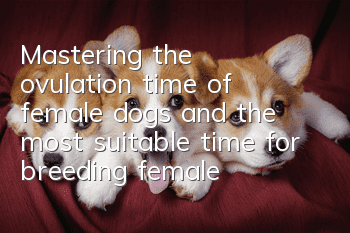Mastering the ovulation time of female dogs and the most suitable time for breeding female dogs

Among the many reasons for empty pregnancy, the inability to determine the female dog’s ovulation time and the most suitable breeding time may be an important reason for empty pregnancy. The author analyzed the method of judging the ovulation time of female dogs from the aspects of investigating the birth history, clinical examination, laboratory examination, observing the changes of uterus and ovaries with laparoscopy, etc., and tried to find the method to determine the most suitable dog breeding time for use.
Teacup Dog
1. Investigate the reproductive history to mainly understand the age, health status, epidemic prevention system, feeding and management, the time and cycle of the last estrus, pregnancy and delivery conditions, number of litters, weaning time and number, family reproductive capacity, whether to use contraceptives or pregnancy Interrupting medications, etc.
2. Clinical examination
(1) Vaginal examination. In the early stage of estrus, the vulva is edematous, enlarged, and bleeding secretions, and the area around the vulva and tail hairs are moist and sticky; in estrus, the swelling is obvious, and the tail swings to one side when touching the vulva and vulva, and the posterior drive increases. In the later period of this period, the edema is somewhat It subsides; it recovers 1 to 2 weeks after the end of estrus, and the vulva is small, wrinkled, and has good tension.
(2) Vaginal secretion examination. During certain stages of estrus, labor and postpartum, and under certain pathological conditions, uterine and vaginal secretions flow out. The secretion in proestrus is blood-like, and the color of the secretion gradually changes to yellow or grass yellow. There is little or no secretion in late estrus and anestrus.
(3) Vaginal examination. After cleaning the vulva, use a vaginal dilator and an appropriate light source to observe the mucosa and secretions and feel the vaginal tension. In the early stage of proestrus, the edema is obvious, the mucosal surface is smooth, and the crotch opening device is easy to insert; in the later stage of this period, there is resistance, the mucosa is rose red, there is edema, there are wrinkles and a large amount of blood-stained secretions, and the cervix is slightly open. During the estrus period, there is resistance when inserting the ejaculation device, and the mucous membrane becomes thickened, pale, and wrinkled. Since changes in the vulva, vagina and secretions are secondary to changes in hormone levels in the body, estimating ovulation time is not accurate enough and requires experience. When this method is used to determine the breeding time, two breedings should be performed 48 hours apart.
3. Laboratory examination
(1) Cytological examination. Vaginal epithelial cytological changes are closely related to changes in estrogen levels, and examinations should be conducted 24 hours apart and combined with other clinical examinations and reproductive history investigations. When sampling, fix the dog on the table to keep the vagina horizontal, separate the vulva with two fingers, and use cotton balls and thin tubes soaked in isotonic saline to collect samples. When using cotton ball sampling, insert the cotton ball into the vagina and turn it out; when using thin tube sampling, insert the thin tube into the cervix and withdraw it slightly, squeeze out a few drops of isotonic saline, and then suck it into the thin tube before taking it out. . Place the collected sample on a glass slide, push it with another glass slide, and then fix it. After staining, use an ordinary microscope to examine. Those who do not stain can use a phase contrast microscope to examine. In proestrus, the epithelial cells are nucleated, and a large number of basal-like cells and intermediate cells appear in the early stage, as well as white blood cells and red blood cells;In the later stage, the number of basal cells, small and medium-sized cells, and red and white blood cells decreases, and eosinophilic epidermal cells appear. At the beginning of estrus, a large number of eosinophilic and basophilic epidermal cells and some large intermediate cells appear, as well as a small number of anucleate cells and red blood cells; in the later stage of this period, there are mainly eosinophilic epidermal cells, anucleate cells and cell debris, white blood cells and nucleated epithelium. The cells reappear. Epidermal cells still exist in late estrus, and basal cells and intermediate cells increase. White blood cells increase in the first 10 days of this period, then decrease, and disappear after 20 days. Foam cells and late estrus cells appear in large numbers. A small number of basal cells, intermediate cells and white blood cells can be seen during the anestrus stage, and sometimes foam cells can be seen. It should be noted that vaginal cytology cannot determine the occurrence of LH surge and the time of ovulation, but it can be used to infer cycle stage.
(2) Measurement of progesterone in blood. The rapid progesterone measurement method is used to measure the progesterone concentration in peripheral blood three times a week. It can be seen that when the LH (luteinizing hormone) peak occurs, the progesterone concentration begins to increase, and when ovulation begins, the progesterone concentration increases rapidly. This method can more accurately determine the time of ovulation, thereby improving the breeding and conception rate. Since there is currently no rapid method for measuring LH, the breeding time cannot be determined by directly measuring LH.
4. Use laparoscopy to observe changes in the uterus and ovaries
Some data show that observing the vascular changes in the uterus of a female dog can determine the ovulation time of the female dog.
In fact, by using laparoscopy to observe the development of follicles on the ovary, you can accurately determine the time of ovulation. That is, part of the follicle protrudes about 1.5 mm from the surface of the ovary, and its top is transparent, which indicates that the female dog is about to ovulate. At this time, The optimal time for breeding. If the "follicle" seen on the ovary is collapsed in the middle and is fleshy red in color, this indicates that ovulation has occurred and the "follicle" at that time has developed into the corpus luteum. Through several practices, the author found that this method is unrealistic, because the ovaries of dogs are different from those of other domestic animals. The ovaries of most female dogs are surrounded by thick fat, making it difficult to see the development of follicles.
Whether this method is feasible remains to be proven in practice.
5. Determine the most suitable planting time
Since it takes 2-5 days after ovulation to complete meiosis, and it takes about 7 hours for sperm to be capacitated in the female dog’s reproductive tract, the most suitable breeding time can be determined based on the following parameters.
Determination of the most suitable planting time
Parameters…….The most suitable planting time
The female dog starts to be interested in the male dog …….3-5 days later
The female dog is willing to accept the male dog climbing... 2—3 days
Bloody vaginal discharge …….10-14 days
Vaginal discharge turns to straw yellow... 2-3 days
Progesterone concentration increases rapidly……..2-3 days
Nuclear and epidermal cells …….when appearing in large numbers
White blood cells…….when estrus reappears
- How to treat urinary tract stones in dogs? Dogs may need surgery!
- What should I do if my dog has no milk? The owner should check quickly and don’t let the puppies starve to death.
- Dog’s anal gland odor, please note that this is a sign of your dog’s health!
- What are the symptoms of dog pain? How to detect dog pain early
- How to make your dog like to eat dog food Four ways to make your dog fall in love with dog food
- Can dogs digest peach pits if they eat them? Can dogs digest peach pits if they accidentally eat them?
- How to protect your dog’s food? Teach you tips on training your dog
- Why do dogs defecate everywhere? How can dogs stop defecating everywhere?
- What should I do if my dog has lupus? Immune system diseases should not be underestimated
- If your dog's hair is cut and the skin is cut, the flesh is exposed. If the dog's hair is accidentally cut and the skin is cut, it must be disinfected immediately.



